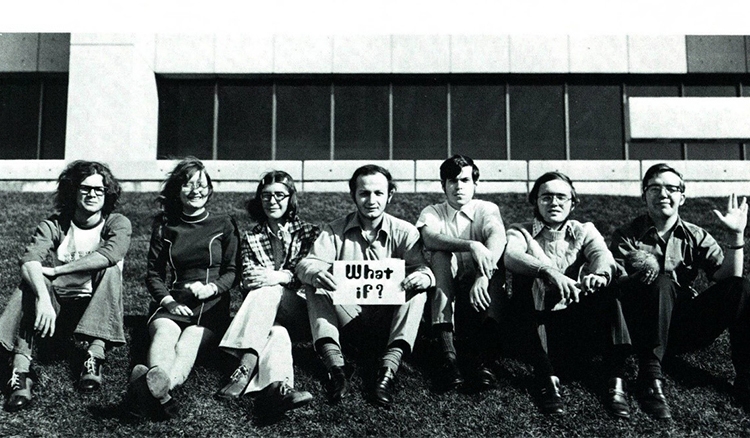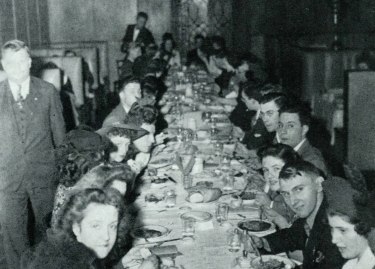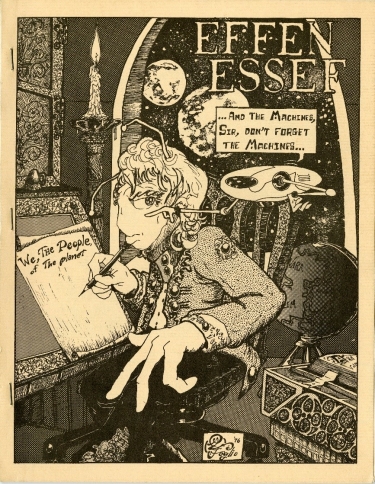 The Fellowship of Science Fiction Freaks and Armchair Speculators in 1974. (DePaul University/Special Collections and Archives)
The Fellowship of Science Fiction Freaks and Armchair Speculators in 1974. (DePaul University/Special Collections and Archives)
April is National Poetry Month, a time dedicated to celebrating poetry in its many forms. An exploration of DePaul's past student poets and poetry publications uncovers a long-enduring history of various student literary groups and publications.
While most in the DePaul community are familiar with long-running student publications such as "Crook and Folly" - formerly known as "Threshold" and "Shantih" - or the French-language "Mille-Feuille," many may not be as familiar with the older organizations and publications that helped to lay the foundations for these DePaul institutions. Although most of the organizations detailed in this piece were not nearly as long lasting as the above-mentioned publications have been, they helped to foster an appreciation for literature and the humanities on the DePaul campus that has continued into the present day.
 The Edgar Allan Poe Literary Club at its annual banquet in 1943. (DePaul University/Special Collections and Archives)
The Edgar Allan Poe Literary Club at its annual banquet in 1943. (DePaul University/Special Collections and Archives)
One of the earliest literary organizations at DePaul was the Edgar Allan Poe Literary Club, which held its first meeting on Oct. 19, 1938. Despite its very literary name, topics covered at meetings of the Poe Club went well beyond 19th century American poetry and literature. Every month, the club would meet to listen to a new guest speaker, followed by a lively discussion and tea. Occasionally, meetings would also include additional musical or dramatic performances. Each guest speaker came with a unique background and topic. The speaker at the first meeting was Stanley Read, a DePaul instructor who spoke about the life of painter William Hogarth. Later guests included Stephen Milos, a professional reader who "dramatized several readings on trees...in costume;" Irv Kupcinet, the legendary Chicago sports journalist who lectured on the effect that the draft had on the sports world; and poet and journalist Dewey R. Jones, best known for his 12-year career at the African-American Chicago newspaper, "Chicago Defender."
At the end of the Poe Club's inaugural academic year, "The DePaulia" noted the club had "concluded a remarkably successful year, raising itself to the top of the active organizations of the school." According to accounts in both the newspaper and the yearbook over the next four years, the Edgar Allan Poe Literary Club only continued to grow in popularity, with its lectures and annual banquets often filled to capacity. Despite this, the last mention of the club in any publication is from the spring of 1943, with no explanation given for its disappearance. Sadly, one of DePaul's earliest and most successful clubs may have been a victim of the reduced student population during World War II.
 The cover of the April 1976 edition of 'Effen Essef.' (DePaul University/Special Collections and Archives)
The cover of the April 1976 edition of 'Effen Essef.' (DePaul University/Special Collections and Archives)
Throughout the years, DePaul has been the home of multiple student publications both large and small. One of the more notable smaller publications is most certainly "Effen Essef," the official zine of the Fellowship of Science Fiction Freaks and Armchair Speculators from 1975 to 1977. The Fellowship was a student organization dedicated to the science fiction genre and "Effen Essef" was the literary manifestation of that love. While the fanzine was strictly nonfiction, topics varied widely and included Hugo award nominations, reviews of science fiction television shows and movies, and directions on how to build various scientific equipment.
"Effen Essef" also had a comedic bent and would often include comics, silly songs and silly poems. What is arguably most notable about the zine today, however, is the artwork. While co-editor Phil Foglio created a good portion of it, the artwork as a whole came from a large number of DePaul students, and rarely fails to be stunning. Despite being a seemingly niche publication, "Effen Essef" demonstrated DePaul students' wide array of literary and artistic abilities.
When looking over the history of student organizations at DePaul, it quickly becomes clear literary interest has always been alive and well among the student body. While this piece focused on just two organizations, there are dozens of others that have existed over DePaul's long life. DePaul's rich literary history guarantees literature and humanities-based organizations and publications will always have a place on campus.